The Usborne Complete Book of the Human Body
By Anna Claybourne
Review by Tonya Dirksen
"If bones are hard, how do children's bones grow?"
This question and many more are answered in the Usborne Book of the Complete Human Body. This is a fascinating book packed with interesting facts, beautiful illustrations and engaging and clear text. There are fantastic microscope and x-ray pictures that enhance each topic.
This book is also Internet-linked which means you can link to a website which will give you more information about a particular topic. This is a great resource for school reports and projects. The websites often have more experiments and activities that can easily be turned into a science project. Many of the pictures and illustrations featured in the book are downloadable and are excellent for homework and reports.
This book is also Internet-linked which means you can link to a website which will give you more information about a particular topic. This is a great resource for school reports and projects. The websites often have more experiments and activities that can easily be turned into a science project. Many of the pictures and illustrations featured in the book are downloadable and are excellent for homework and reports.
To give you an example, let's examine the skeleton page. The skeleton is discussed over a double page spread. There is a large x-ray of a walking human skeleton with all of the bones labeled. Another picture is a close-up x-ray of a wrist that points out the carpals or wrist bones. At the top is a microscope picture of the honeycomb structure inside the bone shown at about 70 times life-size. There is also a close-up of the stapes, the smallest bone in the body. At the bottom is a box explaining what bone detectives or archaeologists do. Above that is a beautiful, downloadable illustration of the layers of the bones.
The Internet link for this page takes you to a website where you can take a tour of the human skeleton and play an interactive game. You can do that right now by going to http://www.usborne-quicklinks.com/, use the keywords "complete body" and page 18.
Framing these beautiful pictures and illustrations are facts about the skeleton. Let's answer our earlier question: "If bones are hard, how do children's bones grow?" The answer is that their skeletons aren't all bony. Some of their bones are made of a softer material, called cartilage. The illustration shows a 12 year-old's bones containing cartilage discs. The bone next to it is an adult bone in which the cartilage has turned to bone. To see this please turn to page 19!
To order this book and other Internet linked books please visit my website at http://www.tonyasbooks.com/ or call me at (916) 812-2875.






No comments:
Post a Comment